Cold and Hot Forging: Fundamentals and Applications / Edited by Taylan Altan, Gracious Ngaile, Gangshu Shen
Подождите немного. Документ загружается.

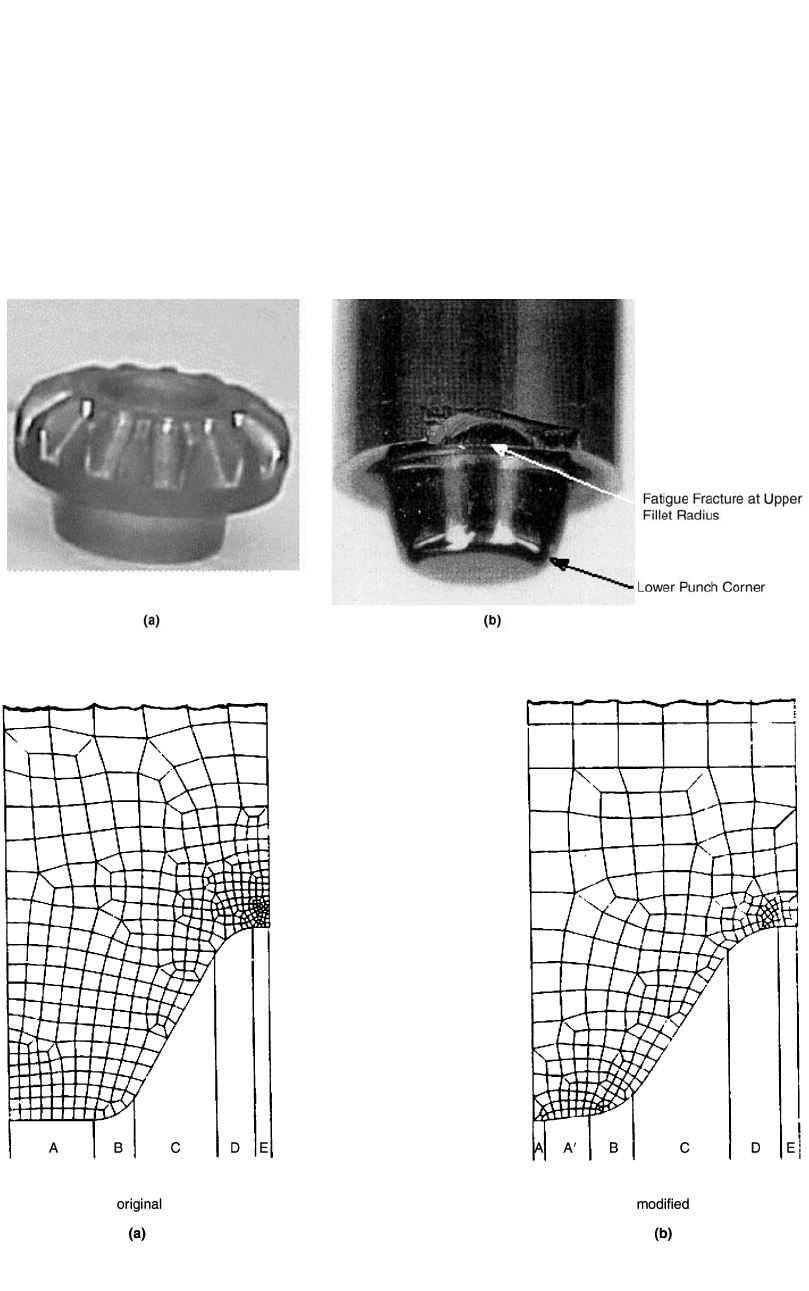
308 / Cold and Hot Forging: Fundamentals and Applications
which facilitates the propagation of cracks
formed in the plastic zone.
22.7.2 Backward Extrusion of Constant
Velocity Joints—A Case Study
In cold forging of outer races for constant ve-
locity joints, tool stresses during the backward
extrusion operation lead to very high loading
conditions in the tool inserts. Therefore, fatigue
fracture is the common failure mode for the tool-
ing. Figure 22.14 illustrates the backward extru-
sion process and the locations where fatigue
fracture is experienced [Nagao et al., 1994].
Figure 22.15 shows the results from the fa-
tigue analysis at the cup bottom, where fatigue
Fig. 22.23
(a) Finite-element model of original punch geometry. (b) Finite-element model of modified punch geometry (A, face;
B, lower punch corner; C, cone angle; D, fillet radius; E, edge) [Lange et al., 1992b]
Fig. 22.22 (a) Bevel gear. (b) Punch used to form bevel gear [Lange et al., 1992b]

Die Failures in Cold and Hot Forging / 309
fracture was experienced under production con-
ditions. Once again, there is a localized plastic
zone and tensile maximum principal stresses in
this region. Both of these conditions contribute
to the onset of fatigue fracture. Similar results
were obtained in the flange region [Nagao et al.,
1994].
In order to further verify the fatigue analysis
method, tooling capable of developing a stress
state similar to the actual tooling (Fig. 22.14)
was manufactured and tested at Honda Engi-
neering Co.
With this tooling, cracks were experienced in
the flange area after 7000 parts. Once again, fa-
tigue analysis of the tooling showed a large plas-
tic zone and tensile maximum principal stresses
in the flange area (Fig. 22.16). In order to im-
prove tool life, a new tooling geometry with a
profiled container was designed (Fig. 22.17).
The results from the fatigue analysis on this tool-
ing showed that there was no plastic zone in the
flange area, and the maximum principal stresses
remained compressive. With this new tooling
geometry, 21,000 parts were forged without ex-
periencing any cracks.
22.7.3 Knockout Pin Insert—A Case Study
This case study analyzed a knockout pin in-
sert that was used to indent a hole on the bottom
of a workpiece in a cold heading operation. The
Fig. 22.24
(a) Normal stress distribution for original punch geometry. (b) Normal stress distribution for modified punch geometry
(A, face; B, lower punch corner; C, cone angle; D, fillet radius; E, edge) [Lange et al., 1992b]
Table 22.3 Upset forging conditions used in
die wear tests [Bobke, 1991, and Luig, 1993]
Press
Type: mechanical
Capacity: 3.09 MN (347 tonf )
Stroke: 7 in. (180 mm)
Stroke rate: 2/s
Cycle time(a): 13 s
Billet
Material: 1045 steel
Temperature: 2010 F (1100 C)
Diameter: 0.8 in. (20 mm)
Height: 1.2 in. (30 mm)
Dies
Material: H-10
Coating: various
Temperature: 430/570 F (220/300 C)
Lubrication: various
(a) The cycle time included (Fig. 22.7) placing the billet on the lower die, the
billet resting on the lower die, the forging stroke, the forged billet resting on the
lower die, removal of the forged billet, and lubrication (when applied).
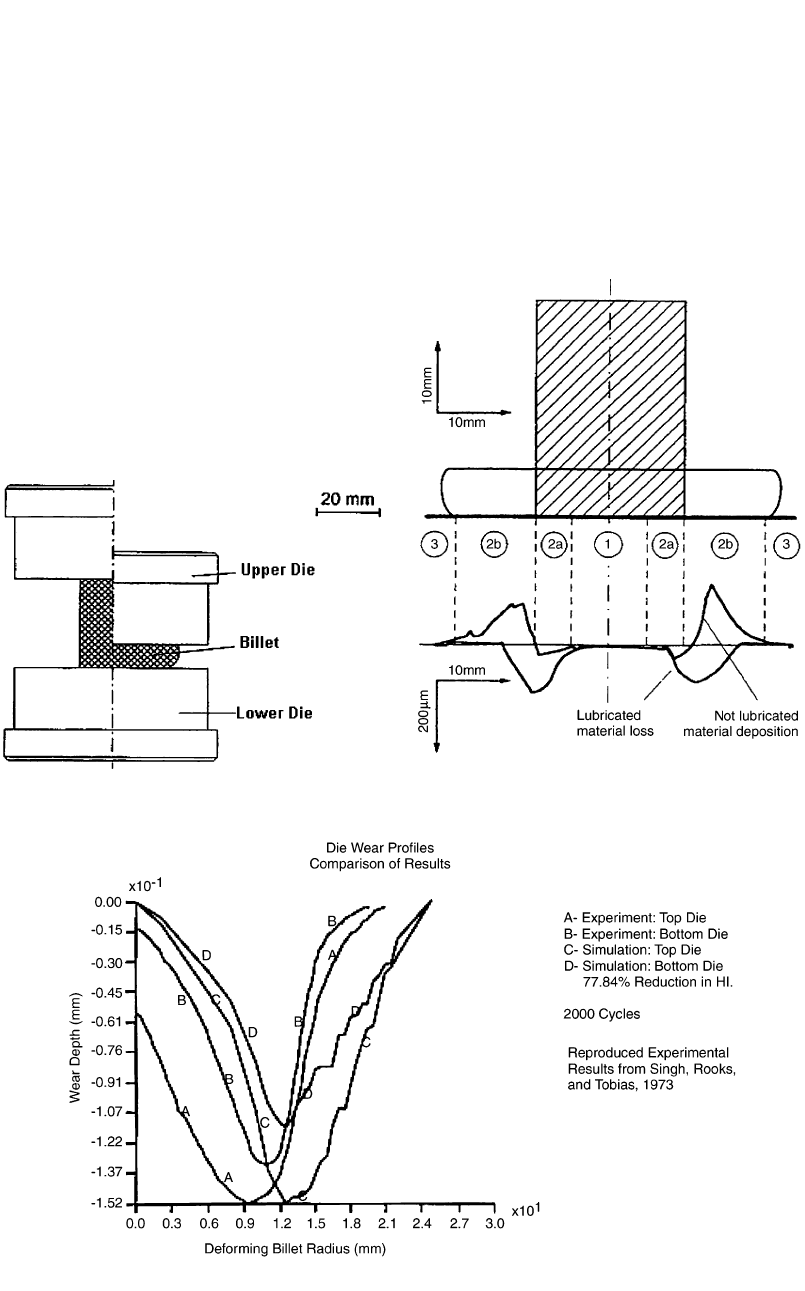
310 / Cold and Hot Forging: Fundamentals and Applications
insert and original pin design are shown in Fig.
22.18 along with the point of failure. The origi-
nal insert had an average tool life of 53,000 parts
[Hannan et al., 2001].
Figure 22.19 shows the FEM model of the
knockout pin operation used for the fatigue anal-
ysis. Figure 22.20 shows that there is a large
tensile maximum principal stress in the region
of the failure point [Hannan et al., 2001].
One design change analyzed in this case study
was to split the pin insert where it was failing.
The design is shown in Fig. 22.21. The radius
where failure occurs is eliminated using a
straight pin (E) and a sleeve (D). This tool was
manufactured for a production run. The resulting
tool life increased from 53,000 parts to 200,000
parts. This is about a 300% increase in tool life
[Hannan et al., 2001].
22.7.4 Bevel Gear Punch—A Case Study
This case study analyzed the fatigue fracture
of a punch (Fig. 22.22b) used in the cold forging
Fig. 22.25 Upset forging process [Luig, 1993]
Fig. 22.26
Typical wear profile for upset forging [Doege et
al., 1996]
Fig. 22.27 Comparison between predicted and experimental die wear [Liou et al., 1988]
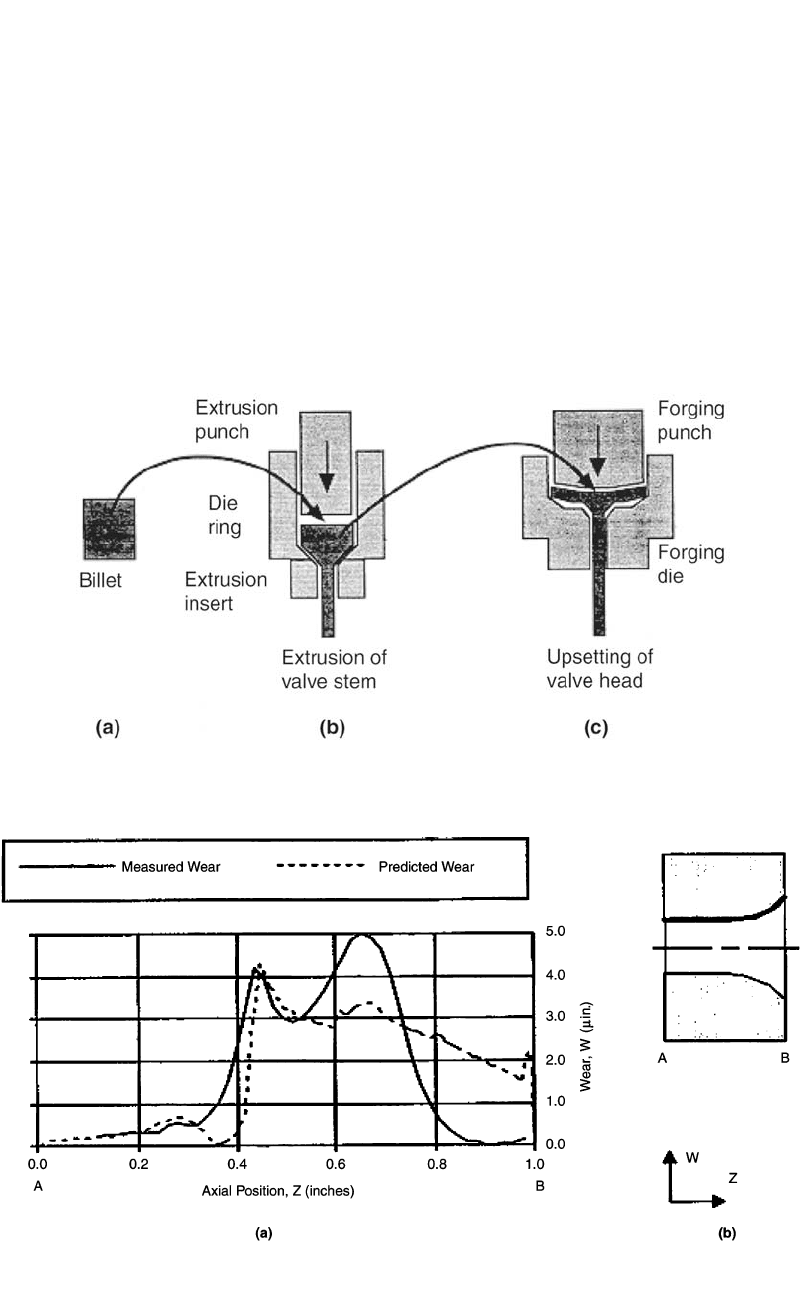
Die Failures in Cold and Hot Forging / 311
of a straight bevel gear (Fig. 22.22a). The finite-
element model is shown in Fig. 22.23(a). Fa-
tigue analysis of the punch showed that very
high stresses were generated in the lower punch
corner and the upper fillet radius (Fig. 22.24a).
By modifying the punch geometry (Fig. 22.23b),
it was possible to reduce the peak stresses, es-
pecially at the upper fillet radius where the fa-
tigue fracture occurred (Fig. 22.24b). As a result
of these geometric changes, the punch life was
increased by a factor of 6 to 8 [Lange et al.,
1992b].
22.8 Prediction of Die Wear and
Enhancement of Die
Life in Hot Forging Using FEM
Several studies have been conducted in an at-
tempt to estimate die life in hot forging [Liou et
al., 1988]. The ability to predict die wear allows
for the optimization of process variables such
that die life is improved [Tulsyan et al., 1993].
Many researchers have applied FEM to esti-
mate die wear in hot forging. In general, all of
Fig. 22.28
Exhaust valve forming process. (a) Initial billet. (b) Extrusion of valve stem. (c) Upsetting of valve head [Tulsyan et al.,
1993]
Fig. 22.29
(a) Comparison between predicted and experimental die wear. (b) Axial position along extrusion die throat (picture is
rotated 90) [Painter et al., 1995]
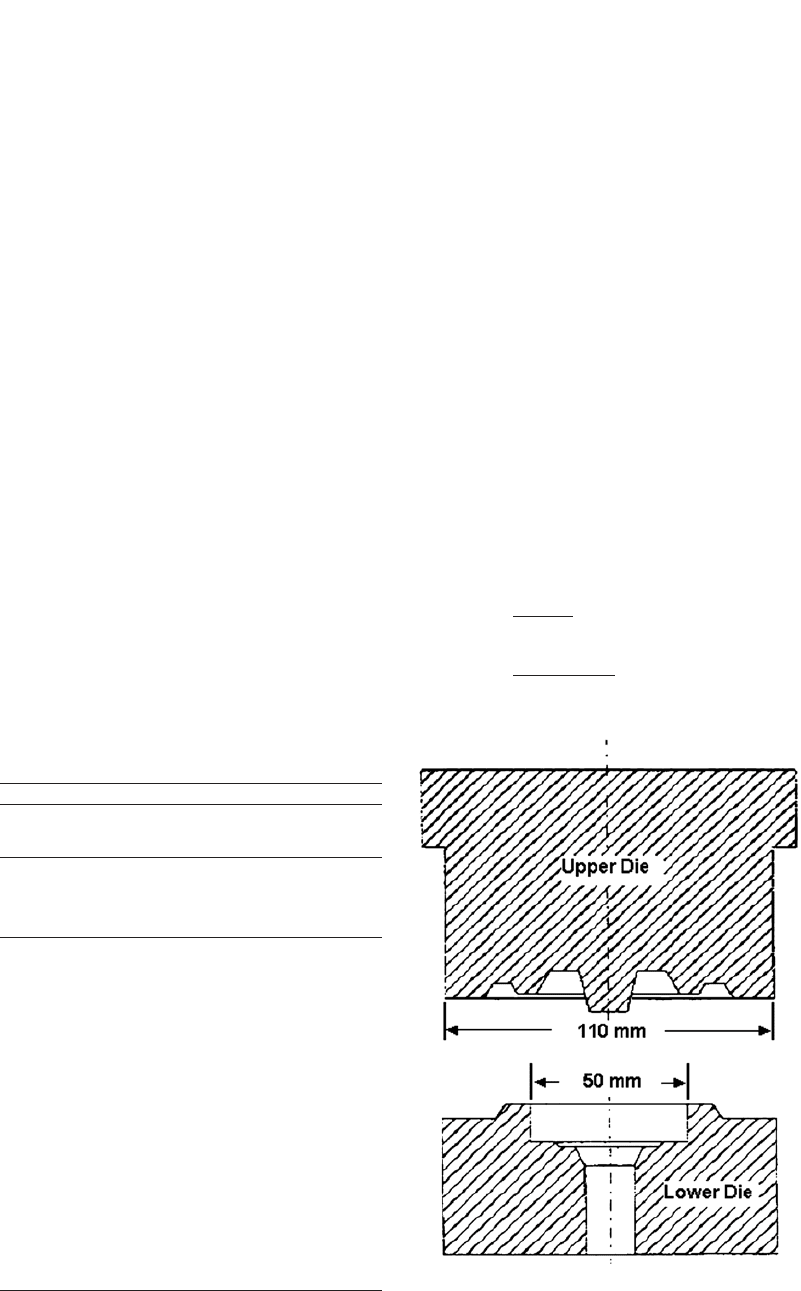
312 / Cold and Hot Forging: Fundamentals and Applications
the results have been similar. The general pro-
files of the predictions have agreed with exper-
iment; however, predicting the exact magnitude
of die wear is difficult [Dahl et al., 1999, and
Lee and Jou, 2003].
The prediction of die wear (fatigue fracture as
well) with FEM has the following specific ad-
vantages [Painter et al., 1995]:
●
Die changes can be scheduled, based on es-
timated die lives, in order to reduce unex-
pected machine downtime.
●
Forging parameters such as press speed, die
materials, and workpiece and die tempera-
tures can be optimized to increase die life in
an economical manner, as opposed to expen-
sive experimental studies.
●
The effects of die geometry changes on die
wear can be rapidly investigated, again
avoiding the high cost of experimental stud-
ies.
22.8.1 High-Speed Hot
Upset Forging—A Case Study
In hot upset forging, the temperature distri-
butions at the top and bottom surfaces are not
symmetric. Due to the free resting of the work-
piece on the bottom die prior to deformation of
the billet, heat is transferred from the billet to
the lower die. The different temperatures on the
billet surfaces result in an asymmetric flow pat-
tern of the deforming workpiece. This phenom-
enon, along with the asymmetric temperature
distributions on the die surfaces, strongly affects
die wear behavior on the two surfaces [Liou et
al., 1988].
Experimental Wear Measurement. Mea-
surements of die wear in a simple upsetting
operation were made at the IFUM at the Uni-
versity of Hannover in Germany, using the con-
ditions given in Table 22.3 [Bobke, 1991, and
Luig, 1993].
Figure 22.25 illustrates the upset forging pro-
cess. Typical wear profiles after upsetting are
shown in Fig. 22.26.
Analytical Wear Prediction. In order to pre-
dict die wear using FEM analysis, adhesive wear
was considered to be the dominant wear mech-
anism. Therefore, a differential form of Holm’s
wear equation was adopted:
dW • dL
dV ⳱ K •
adh
H
p • dA • U • dt
⳱ K • ⳱ dZ • dA (Eq 22.2)
adh
H
Table 22.4 Summary of K
abr
and K
adh
values in
extrusion die wear [Painter et al., 1995]
Die set Die material K
abr
K
adh
A H-11 tool steel 3.2 ⳯ 10
ⳮ6
2.6 ⳯ 10
ⳮ3
B Silicone nitride ceramic 6.0 ⳯ 10
ⳮ7
7.0 ⳯ 10
ⳮ3
C H-11 tool steel 1.5 ⳯ 10
ⳮ6
2.0 ⳯ 10
ⳮ3
Table 22.5 Upset forging conditions used in
die wear tests [Bobke, 1991, and Luig, 1993]
Press
Type: mechanical
Capacity: 3.09 MN (347 tonf )
Stroke: 7.1 in. (180 mm)
Stroke rate: 2/s
Cycle time(a): 13 s
Billet
Material: 1045 steel
Temperature: 595 F (1100 C)
Diameter: 1.2 in. (30 mm)
Heght: 1.6 in. (40 mm)
Dies
Material: H-10, H-12, H-13
Hardness: 0.17/0.22/0.25 psi (1200/1500/1700 Pa)
Temperature: 285/430/570 F (140/220/300 C)
Lubrication: various
(a) The cycle time included (Fig. 22.7) placing the billet on the lower die, the
billet resting on the lower die, the forging stroke, the forged billet resting on the
lower die, removal of the forged billet, and lubrication (when applied).
Fig. 22.30 Hot precision forging die [Bobke, 1991]
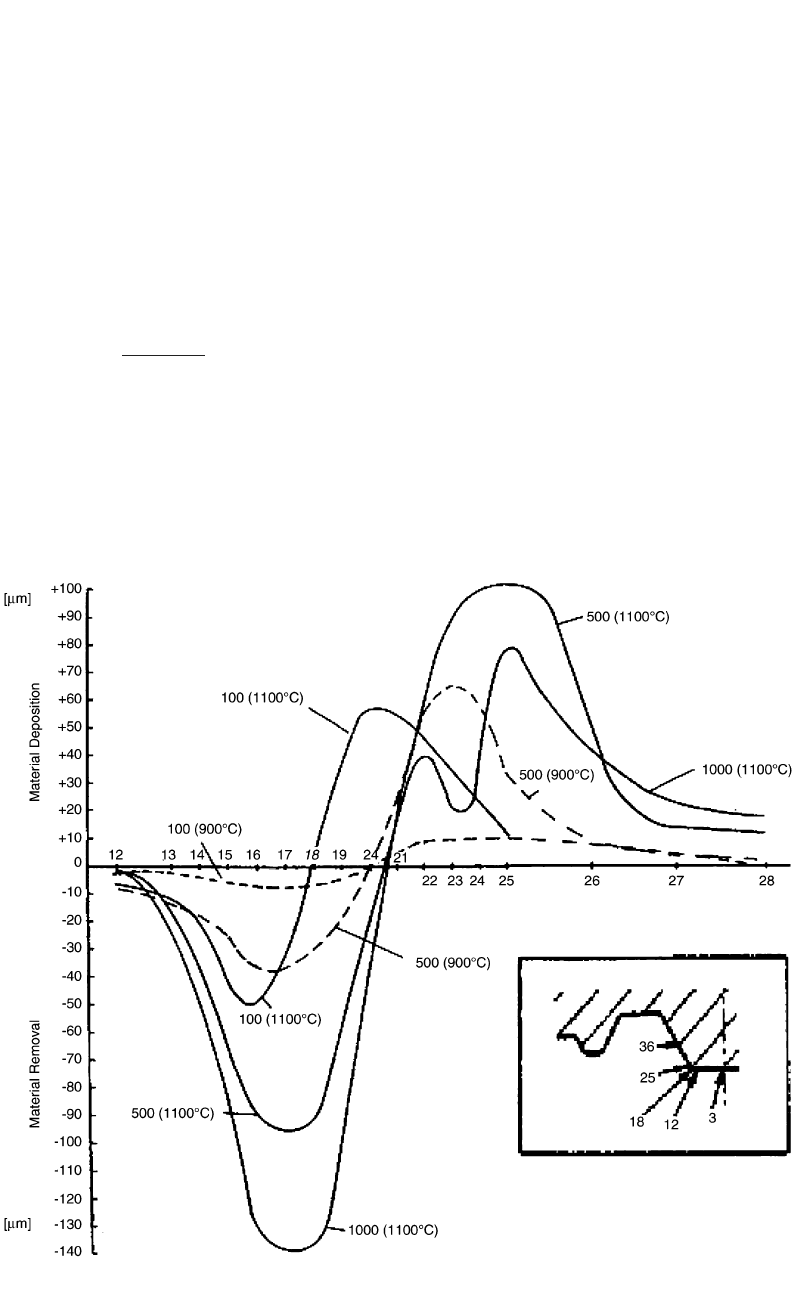
Die Failures in Cold and Hot Forging / 313
where dV is the wear volume and is equal to
dZ • dA (wear depth • contact area), dW is the
normal load to compress the billet and is equal
to p • dA (interface pressure • contact area), dL
is the sliding distance and is equal to U • dt (slid-
ing velocity • time), H is the die hardness, and
K
adh
is the dimensionless adhesive wear coeffi-
cient. It should be noted that the interface pres-
sure and the sliding velocity are local values.
Thus, the wear depth can be predicted as:
M
p • U • Dt
ij ij
Z ⳱ K • ...i ⳱ 0, N
i
兺
adh
H
j⳱1
ij
(Eq 22.3)
where Z
i
is the accumulated wear depth at the
ith node, Dt is the time interval of the calculation
step, M is the total number of calculation steps,
N is the total number of nodes on the die surface,
i represents the ith node, and j represents the jth
time step [Liou et al., 1988].
In this case, the FEM simulation of the hot
upset forging process was divided into ten steps.
On completion of each step, the parameters
needed for the die wear model (Eq 22.3) were
extracted from the FEM simulation. In addition,
based on the approximations given in Table
22.1, the wear coefficient was assumed to be
K
adh
⳱ 7.0 ⳯ 10
ⳮ5
. With this data, Eq 22.3 was
used to calculate the predicted die wear at each
contact node on the upper and lower die for the
ten simulation steps of one deformation cycle
[Liou et al., 1988].
In order to compare the die wear predictions
to experimental results, the predicted results
were scaled up to 2000 forging cycles. Figure
22.27 shows the comparison between the pre-
dicted and experimental die wear.
It is immediately noted that the maximum die
wear depth was greater on the top die than on
the bottom die. As discussed previously, this
may be attributed to asymmetric temperature,
Fig. 22.31 Measured die wear profile vs. die temperature vs. number of forging cycles. [Bobke, 1991]
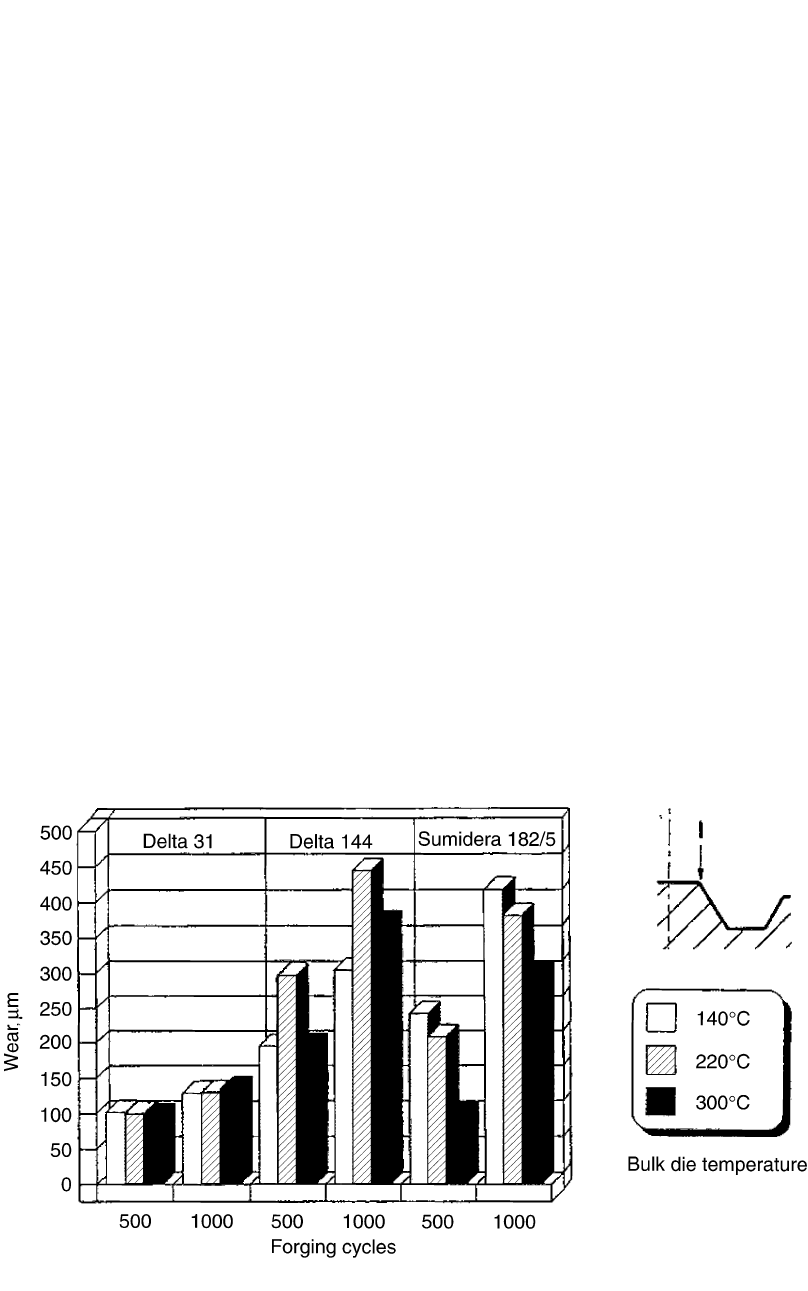
314 / Cold and Hot Forging: Fundamentals and Applications
sliding velocity, and interface pressure distribu-
tion on the top and bottom die due to the die-
chilling effect of the free resting billet on the
lower die prior to deformation. The figure also
shows that the die wear profile predicted by the
model closely resembled experimental results.
The difference between the maximum wear
depth on the bottom die predicted by the model
and the experiment was explained by consider-
ing the effect of consecutive forging cycles. In
this analysis, FEM simulation of the heat trans-
fer for the postfree resting and empty periods of
the first upsetting cycle was performed. The
temperature fields in the top and bottom die were
then used as the initial temperatures for the sec-
ond upsetting simulation and so on. Simulation
of three consecutive forging cycles predicted a
temperature increase in the bottom die but not
in the top die. Because the temperature of the
bottom die increases, its hardness decreases, and
thus, wear increases. This explains why scaling
the wear predicted on the bottom die for the first
forging cycle resulted in a maximum wear depth
less than that indicated by experiment.
22.8.2 Extrusion and Forging of
Exhaust Valves—A Case Study
As Fig. 22.28 shows, exhaust valves are typ-
ically formed in two stages. In the first stage, the
valve stem is formed by extruding the bottom of
the billet, and in the second stage, the valve head
is formed by upsetting the top of the billet. The
process is generally completed in a 500 to 700
ton mechanical press at 45 to 60 strokes per min-
ute, with the billet heated to 2000 to 2100 F
(1100 to 1150 C) [Tulsyan et al., 1993].
Experimental Wear Measurement. Mea-
surements of die wear in the extrusion operation
of the exhaust valve forming process were per-
formed. The experiments were performed with
three different extrusion dies. Both the die ge-
ometry and the die material varied from die to
die because it was expected that different wear
mechanisms would dominate in each die. Table
22.4 summarizes the die materials used for the
experiments. The typical wear profile after ex-
trusion is shown in Fig. 22.29. Because there is
relatively little movement between the work-
piece and the die during the second stage, the
die wear measurement of the extrusion die used
in the first stage was the primary focus of this
study [Painter et al., 1995].
Analytical Wear Prediction. In high-speed
hot extrusion and forging of exhaust valves,
abrasive wear is assumed to be the dominant
wear mechanism. Because of the success of the
Holm’s-based adhesive wear equation for high-
speed hot upsetting discussed previously, a simi-
lar model was established for abrasive wear:
Fig. 22.32 Measured die wear at location I vs. die temperature vs. lubricant vs. number of forging cycles [Bobke, 1991]

Die Failures in Cold and Hot Forging / 315
dW • dL
dV ⳱ K • ⳱ K
abr abr
m
H
p • dA • U • dt
• ⳱ dZ • dA (Eq 22.4)
m
H
where all the variables are the same, except K
abr
is the dimensionless abrasive wear coefficient,
and m is an exponent equal to 2 for steels. Thus,
the wear depth can be predicted as:
M
p • U • Dt
ij ij
Z ⳱ K • ...i ⳱ 0, N
i
兺
abr
m
H
j⳱1
ij
(Eq 22.5)
where all the variables are as defined previously
[Tulsyan et al., 1993].
In this case, the FEM simulation was divided
into 18 steps. On completion of each step, the
parameters needed for both the adhesive wear
model (Eq 22.3) and the abrasive wear model
(Eq 22.5) were extracted from the FEM simu-
lation, and both the adhesive and the abrasive
wear depths were predicted, as discussed pre-
viously. Table 22.4 outlines the K
abr
and K
adh
values [Painter et al., 1995].
A comparison of the results from the experi-
mental die wear measurements and the FEM die
wear predictions showed that abrasive wear was
the dominant wear mechanism in extrusion with
ceramic dies, while adhesion was the dominant
wear mechanism in extrusion with tool steel
dies. In order to make this comparison, the ex-
perimental results were scaled down to one forg-
ing cycle. Figure 22.29 shows the comparison
of the results for the ceramic extrusion die. The
predicted die wear profile matched the die wear
experiment; however, the die wear magnitudes
did not exactly match because wear mechanisms
other than abrasion were also acting [Painter et
al., 1995].
Fig. 22.33 FEM model of hot precision forging process [Dahl et al., 1999]

316 / Cold and Hot Forging: Fundamentals and Applications
22.8.3 Hot Precision
Forging—A Case Study
Hot precision forging of complex shapes is
the focus of many manufacturers. The tolerances
on these parts are especially critical. Therefore,
die wear is exceedingly detrimental to these pro-
cesses. Thus, prediction of die wear and en-
hancement of die life is very important to these
manufacturers.
Experimental Wear Measurement. Mea-
surement of die wear for the hot precision forg-
ing process was carried out at the IFUM at the
University of Hannover in Germany, under the
conditions given in Table 22.5 [Bobke, 1991,
and Luig, 1993].
Figure 22.30 shows the precision forging die
used in the experiments. Typical wear profiles
after forging are shown in Fig. 22.31. The ex-
perimental wear depths for three different lubri-
cants are summarized in Fig. 22.32.
Analytical Wear Prediction. It was assumed
that abrasive wear was the dominant wear mech-
anism in hot precision forging. Therefore, the
wear model in Eq 22.5 was used [Dahl et al.,
1999].
Figure 22.33 shows the FEM model of the hot
precision forging process. On completion of
each step, the parameters needed for the die wear
model (Eq 22.5) were extracted from the FEM
simulation, and the wear depth was predicted, as
discussed previously. Based on typical experi-
mental values for two-body abrasion, the wear
coefficient was assumed to be K
abr
⳱ 0.02 [Dahl
et al., 1999].
The maximum predicted die wear and the
maximum measured die wear both occurred at
the corner of the upper die (Fig. 22.31, mea-
surement location 18). In general, the model pre-
dicted that die wear increases with decreasing
corner radius, decreases with increasing friction
factor, and increases with decreasing die hard-
ness (i.e., different materials have different
temperature-hardness curves). This illustrates
the advantage of being able to predict die wear.
It is not intuitive that die wear would decrease
with increasing friction factor. In the case of the
valve extrusion, it was shown that die wear in-
creases with increasing friction factor because
of the increased pressure developed on the die.
In this case, die wear decreases because in-
creased friction acts to decrease the sliding
length [Dahl et al., 1999].
REFERENCES
[Altan et al., 1983]: Altan, T., Oh, S., Gegel,
H., Metal Forming Fundamentals and Appli-
cations, American Society for Metals, 1983.
[Artinger, 1992]: Artinger, I., “Material Science
and Tool-Life,” Budapest, 1992 (in Hungar-
ian).
[Aston et al., 1969]: Aston, J., and Barry, E.,
“A Further Consideration of Factors Affect-
ing the Life of Drop Forging Dies,” J. Iron
Steel Inst., Vol 210 (No. 7), July 1969, p 520–
526.
[Bay, 2002]: Bay, N., class notes, Technical
University of Denmark, 2002.
[Bobke, 1991]: Bobke, T., “Phenomenon of
Edge Layer at Sealing Process of Drop Forge
Tools,” No. 237, IFUM, University of Han-
nover, 1991.
[Dahl et al., 1998]: Dahl, C., Vazquez, V., Al-
tan, T., “Effect of Process Parameters on Die
Life and Die Failure in Precision Forging,”
Report No. PF/ERC/NSM-98-R-15, Engi-
neering Research Center for Net Shape Manu-
facturing, April 1998.
[Dahl et al., 1999]: Dahl, C., Vazquez, V., Al-
tan, T., “Analysis and Prediction of Die Wear
in Precision Forging Operations,” Report No.
PF/ERC/NSM-99-R-21, Engineering Re-
search Center for Net Shape Manufacturing,
May 1999.
[Doege et al., 1996]: Doege, E., Seidel, R., and
Romanowski, C., “Increasing Tool Life
Quantity in Die Forging: Chances and Limits
of Tribological Measures,” NAMRC, 1996.
[Hannan et al., 2001]: Hannan, D., Ngaile, G.,
Altan, T., “Elimination of Defects and Im-
provement of Tool Life in Cold Forging—
Case Studies,” New Developments in Forging
Conference (Stuttgart, Germany), Institute for
Metal Forming Technology (IFU), May 2001.
[Hettig, 1990]: Hettig, A., “Influencing Vari-
ables of Tool Fracture at Impact Extrusion,”
No. 106, Reports from the Institute of Metal
Forming, University of Stuttgart, Springer,
1990.
[Kesavapandian et al., 2001]: Kesavapandian,
G., Ngaile, G., Altan, T., “Die Wear in Pre-
cision Hot Forging—Effect of Process Param-
eters and Predictive Models,” Report No. PF/
ERC/NSM-01-R-42, Engineering Research
Center for Net Shape Manufacturing, Aug
2001.

Die Failures in Cold and Hot Forging / 317
[Knoerr et al., 1989]: Knoerr, M., and Shivpuri,
R., “Failure in Forging Dies,” Report No.
ERC/NSM-B-89-15, Engineering Research
Center for Net Shape Manufacturing, March
1989.
[Knoerr et al., 1994]: Knoerr, M., Lange, K.,
Altan, T., “Fatigue Failure of Cold Forging
Tooling: Causes and Possible Solutions
Through Fatigue Analysis,” J. of Materials
Processing Technology, Vol 46, 1994, p 57–
71.
[Lange et al., 1992a]: Lange, K., Cser, L.,
Geiger, M., Kals, J.A.G., Hansel, M., “Tool
Life and Tool Quality in Bulk Metal Form-
ing,” Annals of the CIRP, 1992, p 667–
675.
[Lange et al., 1992b]: Lange, K., Hettig, A.,
Knoerr, M., “Increasing Tool Life in Cold
Forging Through Advanced Design and Tool
Manufacturing Techniques,” J. of Materials
Processing Technology, Vol 35, 1992, p 495–
513.
[Lee and Jou, 2003]: Lee, R.S., and Jou, J.L.,
“Application of Numerical Simulation for
Wear Analysis of Warm Forging Die,” Jour-
nal of Material Processing Technology, Vol.
140, 2003, p 43–48.
[Liou et al., 1988]: Liou, M., and Hsiao, H.,
“Prediction of Die Wear in High Speed Hot
Upset Forging,” Report No. ERC/NSM-88-
33, Engineering Research Center for Net
Shape Manufacturing, Oct 1988.
[Liug, 1993]: Luig, H., “Influence of Wear Pro-
tective Coating and Scaling of Raw Parts on
Forging Wear,” No. 315, IFUM, University of
Hannover, 1993.
[Matsuda, 2002]: Matsuda, T., “Improvement
of Tool Life in Cold Forging,” Advanced
Technology of Plasticity, Vol 1, 2002, p 73–
78.
[Nagao et al., 1994]: Nagao, Y., Knoerr, M.,
Altan, T., “Improvement of Tool Life in Cold
Forging of Complex Automotive Parts,” J. of
Materials Processing Technology, Vol 46,
1994, p 73–85.
[Painter et al., 1995]: Painter, B., Shivpuri, R.,
Altan, T., “Computer-Aided Techniques for
the Prediction and Measurement of Die Wear
during Hot Forging of Automotive Exhaust
Valves,” Report No. ERC/NSM-B-95-06, En-
gineering Research Center for Net Shape
Manufacturing, Feb 1995.
[Schey, 1983]: Schey, J., Tribology in Metal-
working: Friction, Lubrication, and Wear,
American Society of Metals, 1983.
[Shivpuri et al., 1988]: Shivpuri, R., and Sem-
iatin, S., “Wear of Dies and Molds in Net
Shape Manufacturing,” Report No. ERC/
NSM-88-05, Engineering Research Center for
Net Shape Manufacturing, June 1988.
[Tulsyan et al., 1993]: Tulsyan, R., Shivpuri,
R., Altan, T., “Investigation of Die Wear in
Extrusion and Forging of Exhaust Valves,”
Report No. ERC/NSM-B-93-28, Engineering
Research Center for Net Shape Manufactur-
ing, Aug 1993.
